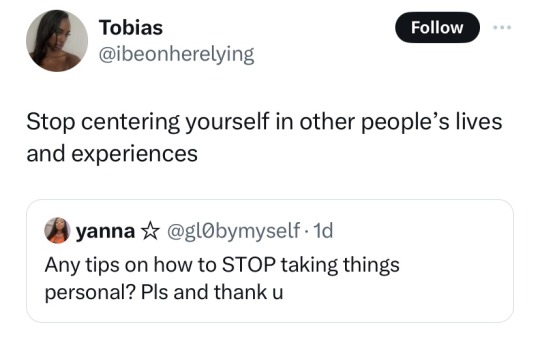#Quick tips
Text
Three tricks to avoid plot armour
Plot armour can be difficult to avoid. We get so attached to our characters that hurting them in any way feels like a betrayal.
But plot armour is detrimental to any good narrative. Having your characters avoid harm, whether that be emotional or physical, means that there aren't any stakes. And without stakes, it's difficult for readers to invest.
There are three simple things you can use to avoid plot armour:
🔵 Injury
🔵 Sacrifice
🔵 Consequence
In every conflict, make sure the resolution contains at least one of these things.
If you don't want to injure your characters, make sure that they sacrifice something, whether that be someone, or an object. If they don't sacrifice anything, make sure there is a consequence. That consequence can be a loss, an emotional wound, or simply a blow to their reputation. The important thing is that your character doesn't remain unscathed by their experience, and they walk out somehow changed.
#nanowrimo#writers#creative writing#writing#writing community#writers of tumblr#creative writers#writing inspiration#writeblr#writerblr#writing tips#writblr#writers corner#plot armor#writing plot#plot bunny#writing resources#quick tips#writing quick tips#writing help#helping writers#help for writers#learn to write#advice for authors#writing advice#writing tips and tricks#story inspiration#let's write#how to write#writers on tumblr
2K notes
·
View notes
Text
How your disabled character's allies react to their disability can make or break the representation in your story: Writing Disability Quick Tips
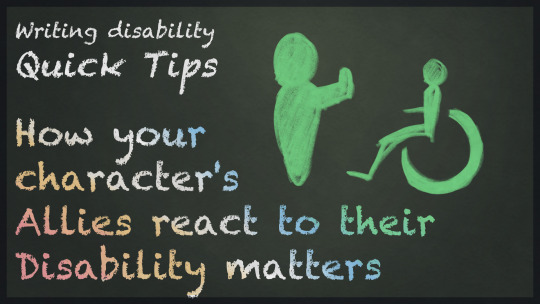
[ID: An image with “Writing Disability quick tips: How your character's allies react to their disability matters” written in chalk the colour of the disability pride flag, from left to right, red, yellow, white, blue and green. Beside the text are 2 poorly drawn people icons in green, one is standing with their hand up to the face of the other, who is in a wheelchair. /End ID]
Something I brought up in my big post about Toph Beifong was how the other characters reacted to Toph pointing out that things were not accessible to her and setting boundaries regarding her disability, which were ignored. I had more to say about it than I thought I did, as it turns out (when isn't that the case lol) but I feel like this is an important aspect of disability representation that is all too often over looked.
You can write the best, most accurate portrayal of a specific disability ever put to screen or page, but it won't mean much if all the other characters, specifically those we're supposed to like and empathise with, treat your character terribly for being disabled and having needs relating to said disability, especially if the story justifies their behaviour.
You see this most often with autistic characters and especially autistic-coded characters. The character in question will be given a bunch of autistic traits, most often traits relating to not understanding certain social dynamics or sarcasm, and when they get it wrong, the other characters we are supposed to like jump down their throat, tease them or outright abandon them.
Autism isn't the only disability that gets treated this way, but it is one of the more common ones that get this treatment. It doesn't matter if you do everything else right when creating an autistic character if the other "good guys" constantly call them annoying, get angry at them or laugh at them for the very traits that make them autistic, or for advocating for their needs.
Likewise, if you have a leg amputee character who is otherwise done well, but is constantly being criticised by their allies for needing to rest their legs or taking too long to get their prosthetics on, it undermines a lot of the other work you've done. Same goes for having a wheelchair user who is accused of being a bore or a stick in the mud because they point out the places their friends want to go to on a group holiday have no wheelchair access, or a deaf character who is accused of being entitled for wanting their family to learn to sign, or anything else.
This isn't to say you can never have moments like these in your stories, but its important to remember that a) people with the same disability as your character will be in your audience. If you spend a whole season of your TV show shaming your autistic character for real traits that real autistic people have, they're not exactly going to feel welcome and may not want to hang around. b) it's going to very, very heavily impact people's perceptions of your "heros" who do this, especially in they eyes of your audience members who share the character's disability or who have had similar experiences. This isn't like calling someone a mean name or being a bit of a dick when you're sleepy, it's going to take a lot to regain audience appeal for the offending character, and depending on exactly what they do and how frequently they do it, they may not even be able to come back from it at all. And finally, c) there should be a point to it outside of just shaming this character and saying the other guy is an asshole. Like I said before, you're character is criticising real people's real disabilities and the traits or problems that come with them, things that they often have no control over, it shouldn't be used as a cheap, quick way to establish a quirky enemies to lovers dynamic or show that one guy is kind of an ass before his redemption arc. If you really must have your characters do this, be mindful of when and how you use it.
#Writing disability with Cy Cyborg#Quick tips#Disability#Disabled#Disability Representation#Writing Disability#Writing#Writeblr#Authors#Creators#Writing Advice#Disabled Characters#On Writing
503 notes
·
View notes
Text
I don't know who needs to hear this, but
if you're working on a sewing project, and you're wishing you could just stick cardboard into the piece to stabilize it and add stiffness, but you also know you don't want to actually put cardboard in your project, there's a product for that.
It's called Timtex, Peltex, Stiff Stuff, a few other names. It's interfacing the thickness of cardboard, but it's sewable, bounces back from most creasing and folding, and won't fall apart if it gets wet.
Just, in case you didn't know.

I cut out some half circles from some Timtex, wrapped them in fabric to make them a little bit stiffer, and velcro'd them to my wheelchair to make sure my big skirts don't get damaged from brushing against my wheels.
206 notes
·
View notes
Text
Need to make a last minute fantasy city/town?
I got just the trick for you. Exaggerate a city you’re already familiar with. A hometown? Capital? Friend’s town? Exaggerate it with fantastical elements and maybe even inside jokes. Not too long needs to pass before you got a convincing fantasy city.
A small rural town known for its flowers? A secluded village swallowed by giant boughs of wildflowers, where masterful but painstakingly traditional druids live.
A city with terrible potholes and construction that never ends? Make it a city built upon massive caverns and canyons, repairing the results of constant dangerous dragon attacks.
Detroit? A city of thieves, that upon entering, with each passing hour you yourself become more and more thief-like.
Really do this! Exaggerate more than one element, and you get a place even more unlike with what you started from.
#quick tips#fantasy cities#worldbuilding#worldbuilding tips#worldbuilding cities#worldbuilding towns#worldbuilding villages#detroit#fantasy towns#quick fantasy tips#writing#writing tips#writing advice#D&D#D&D tips#dungeons and dragons tips#worldbuilding advice#worldbuilding advise#writing advise#this is so much fun trust me#fantasy worldbuilding#fantasy writing#last minute
1K notes
·
View notes
Text




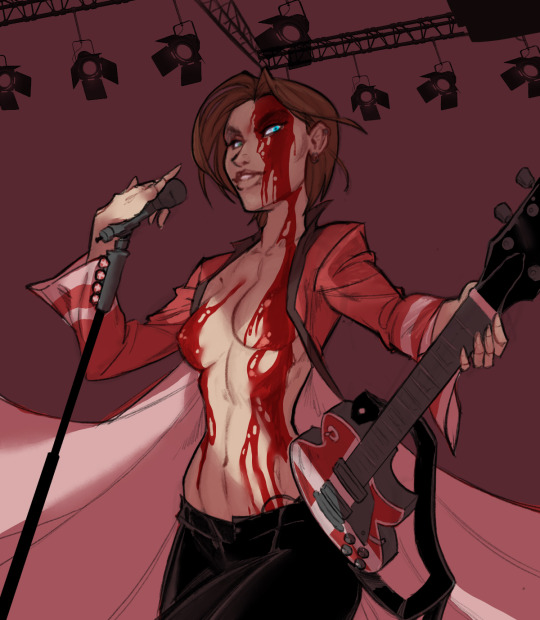
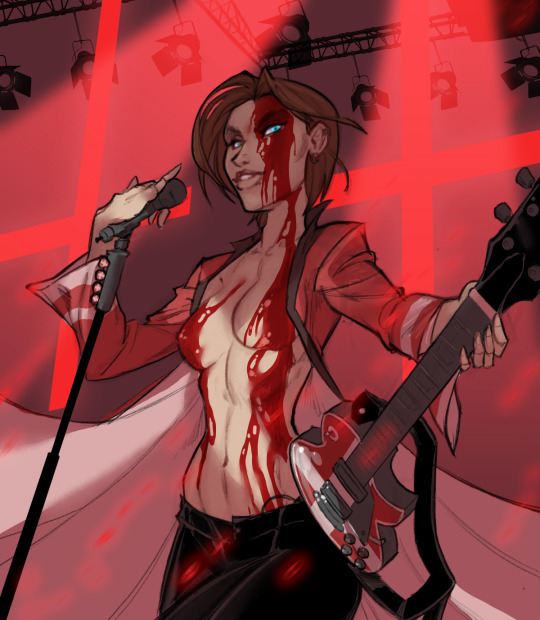

Thought I'd show you guys what goes through my head during my coloring process this morning.
Starting with this picture, you can see how I start with my line art, and even at the beginning phases, I'm blocking out colors for some of my lines. This just helps my brain keep things "on track" as I color. The next step in the process, this time, was to block out the "main shadows". You can see I did an overlay of red as my shadow (since this was indeed going to be a very red image), and the highlights were a graphical "cross" across the body, guitar and cape with only light highlights on the rest of the main figure. This sort of shading can make a big impact and figuring out how light hits things can be a lot of fun to learn.
In the next row, you can see how I block out colors (again on a separate layer) and the middle image combines the layers (the blocked colors are on the bottom, then the lines, and the top shadow layer is set to "Multiply"). I erased the shadow from her eyes, entirely. I add the fake blood on a separate layer. Liquid, and especially blood (real or fake) has its own "rules" about how lights work, so I just find this easier. to manage on its own. The blood layer is also set to "Multiply". Also, note how the perspective really gets amplified when those stage lights and rafters are added at the top.
The final shots are adding more highlights and shadows to the piece, to make them pop. The inverted crosses are just red and the have an red "Outer Glow" on their layer. Same with the little "sparks" I guess you'd call them, that fly in front of and behind Caj. The red flood lights are a bright red gradient that is set to "Screen". The additional shadows are there to add more contrast, and they are done in a light purple layer that's set to "Multiply".
Thanks for looking :D
79 notes
·
View notes
Text
ok @ ppl who are shidding their pants at all the ai garbage in google image searches, well first of all use duck duck go for most things anyway BUT their image indexing is kinda mid so if you have to use google, just slap 'before:2020' (or any other previous year) after your search. no ai images, nilch. no half working adblock datalist just one parameter. I did a quick test to see if it can also help me find old school digital art and dude... the fuckign difference
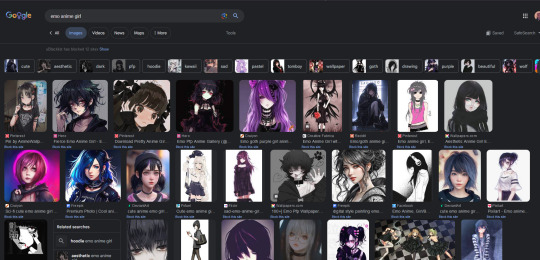
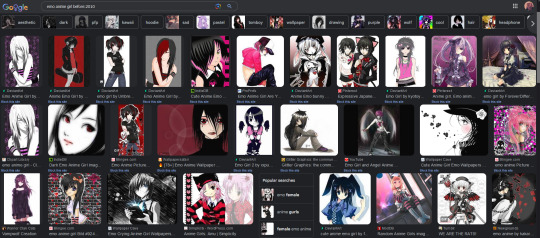
#no ai#google#quick tips#from nix#man ive been having such a hard time finding old web art and images how did i not think of this earlier rip#im dumb XD#90% of all ai images were made after 2020 maybe 2019#so its def does a huge help to cull them#idk how well it will work going forward but so far seems pretty successful
9 notes
·
View notes
Text
Optional Chaining in JavaScript
Introduced in ECMAScript 2020, Optional Chaining is a a modern feature in JavaScript that allows you to read the value of a property located deep within a chain of nested object properties, without having to explicitly validate each reference in the chain.
This simplifies the process of handling potential null or undefined values without the need for cumbersome and error-prone conditional…
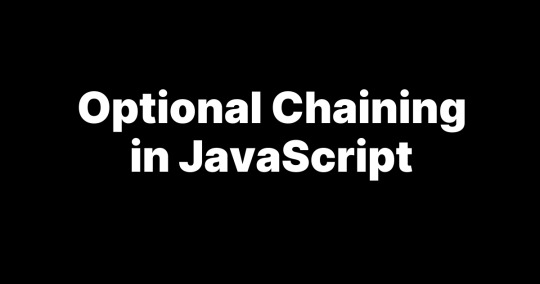
View On WordPress
8 notes
·
View notes
Video
youtube
Quick Tips Apply Transfers for tabletop wargaming miniatures #paintingwa...
#youtube#way of the brush#tutorial#painting#mini painting#painting warhammer#bretonnia#decals#quick tips#just the tip#fresh tips#tabletop gaming#miniature wargaming
4 notes
·
View notes
Text
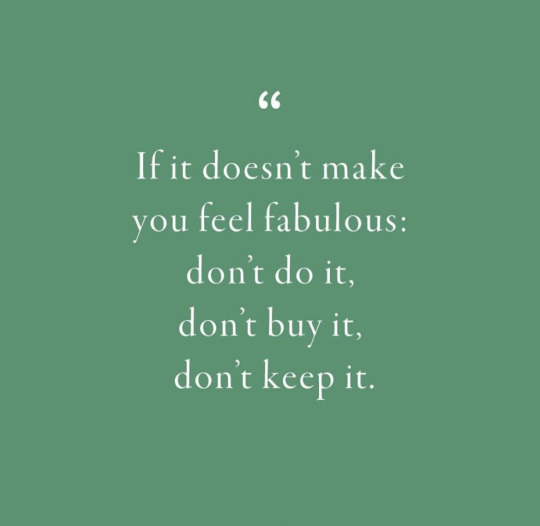
Especially for those who struggle with indecisiveness. 💚
#indecisive#indecision#believe in yourself#trust the journey#pls help#quick thoughts#quick tips#life quotes#life quote of the day#life qoute#aquarius#wise words#wise quotes#wise woman#high value woman#discipline#green#green moodboard#green aesthetic#powerful#quotes
7 notes
·
View notes
Text
Don't be afraid to use your character's name!
To avoid repetition, new writers will often resort to descriptions like "the tall woman," or "the dark-haired man", which breaks up narrative flow and reads as unnatural. Don't over-describe, when just a name will do.
#nanowrimo#writing quick tips#writers#creative writing#writing#writing community#writers of tumblr#creative writers#writing inspiration#writeblr#writerblr#writing tips#quick tips#character development#writing advice#advice for writers#writing tip
903 notes
·
View notes
Text
We have communities - Writing disability quick tips

So often, stories centred on disabled characters, especially in modern settings, emphasise how lonely or isolated the character is because of their disability, especially if it’s a newly acquired disability or one that non-disabled people assume would have a big impact on our ability to do “fun stuff”. This will often be accompanied by statements of “no-one understands what living with [insert disability here]” is like!
And while isolation and loneliness are things a lot of disabled people deal with, a lot of us are not completely alone either, especially in the modern day.
Just like any group of people with shared experiences, we find one another. Sometimes this is through formal systems; some spinal rehabilitation centres for example, will pair newly paralysed people up with a mentor who’s had a similar form of paralysis for much longer to help guide the person while the adjust to their new disability. Other more formal systems can look like disability sporting organisations - the one I used to work for used to specifically encourage very newly disabled people to join so they didn’t feel like the had to learn everything about their disability alone, or support groups.
Other times though, these communities are much less formal. They may look like online forums, such as the ones on Reddit, built by and for disabled people to talk about their experiences and seek recommendations from others in the same boat, or parts of larger social media sites. For example, on Tumblr, there aren’t really any formal groups, but thanks to the hashtags we use in our posts, we often find one another fairly quickly there. We sometimes also carve out our own little subsections of fandom or hobby spaces, brought together by the shared interest itself, how things like disability might impact the way you interpret or interact with it, and how we can modify it (in the case of hobbies) to make it work for us.
A lot of disability communities, formal or otherwise, also form out of necessity, such as advocacy groups run by and for disabled people, and those built around ensuring the rights of disabled people are protected.
Isolation and loneliness are problems within the disabled community that many of us deal with, but this tends to be more in the context of isolation from the wider public, exclusion from public spaces and events (despite there being laws that are supposed to stop this because they’re often not enforced), disconnect from non-disabled friends and family, etc, most of which are the result of systematic issues or the lack of understanding or care and support from non-disabled people in our lives. Not always, but often.
The communities made by and for disabled people though are often (at least in part) made to help make up for this, and they’re more common than you might think, you just have to know where to look. It would be nice to see more creators reflecting this in their work a bit more often, or at least acknowledging that they are there, even if your character chooses not to engage with them.
However, as a reminder to authors and creatives:
These communities, especially the online ones, are for disabled people, they are not there for you to use as a reference as a creator. Some communities are ok with you being there to learn, so long as you listen and don’t try to speak over/bombard their members with questions. Others are not. The ones that are, typically will have something written somewhere if it’s online (e.g. subreddits that accept writers wanting to write disabled characters will often have it written in the “about” section or the rules). There are also dedicated groups and platforms for non-disabled people seeking to learn more about us and our communities, which can be excellent resources for creatives like writers. Just remember to be mindful of where you are and respectful of people’s spaces and boundaries when doing your research.
#Writing disability with Cy Cyborg#Quick tips#Disability#Disabled#Disability Representation#Writing Disability#Writing#Writeblr#Authors#Creators#Writing Advice#Disabled Characters#On Writing
273 notes
·
View notes
Text

Especially air drying jeans, it can sustain them longer
94 notes
·
View notes
Text
You know when you have a really great blouse, but the cuffs are just a little bit too small for your upper arm? You want to just unbutton the cuff button and get your triceps a little breathing room, but don't want to run around with your cuffs unbuttoned?

(Fun fact, the angle of the cuffs on this blouse make them almost impossible to photograph)
Never fear, button extenders are here! These nifty little gadgets will extend the cuff by just a little bit, and they're elastic. Being elastic means that you can keep the cuff edges as close together as possible, while still getting additional movement range when you need it. Much better than leaving the cuff unbuttoned, and you get to be comfortable. Your sleeves will move more naturally and you won't look like you have tricep muffin top.
Here's my easy and fun tutorial for making your own button extenders:
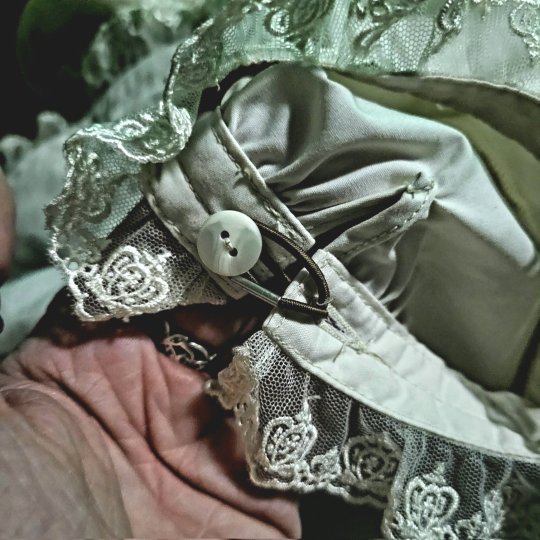
It's just a hair tie and you fold it through the buttonhole and wrap it around the button. It takes about 3 seconds.
Now you have no excuse to leave your cuffs unbuttoned!
96 notes
·
View notes
Text
Character dynamics exercise: Write about your squad going to IKEA together
3 notes
·
View notes
Text







Another picture everyone wants to know more about, and indeed one of my favorites from the past year is this one.
With this image, you can see that I started with the line art in black, only. No colored lines on this puppy -- the "feel" of stained glass demands big, dark lines in this case. You can see that I blocked out the colors in a very basic fashion and added a circle as a "guide" at this point. Eventually, it becomes a crescent moon...
I used an actual shot of the moon to fill in the circle on the second row. I think I just selected the area and used "Paste Into" to make a mask. I then set it to "Multiply" and cut the opacity about 50% so it picked up the gray color I blocked it in with, initially. I also shaded Toki and Eden with a green/blue hue. You can see it's sort of a "softened" cel shading where I blur the edges a bit. The next thing I did was to make the "glass" effect, and the way this was achieved was by selecting different sections of the figures and again using "Paste Into" to put a layer of marble I lifted off Google (see examples here) as a mask. Then I'd select a few more sections, paste a different marble pattern in, and repeat. I'd "Invert" the patterns (so they're black with white "veins") and set them to "Screen". I did the same with the moon, and by the time we've gotten to the last image of the second row, you can see I added a few more "backlights" to the image. This was done with the inclusion of a radial all-white gradient set to "Overlay" above the shadow layer. I also changed the very-back layer from white to black.
For the finishing touches, I added a few more highlights over another layer above everything, and in the layer between the colors and the black background, made a layer of blue radial gradient and some stars on either edge of the moon. The very, very last step was to put a layer of contrasting blue and red gradients above everything and set that to "Soft Light". I've left the gradient layer in the final image set to "Normal" so you can see what it looks like. Little things like this make a big difference in the final composition, and it's fun to experiment with overlays in such ways. :)
Thanks for looking! Hope you got some groovy ideas... Will definitely be pulling out some of my art from the past (and the future, I'm sure) to do more breakdowns like these since I haven't been giving you guys as many tutorials as I've wanted to, lately.
21 notes
·
View notes
